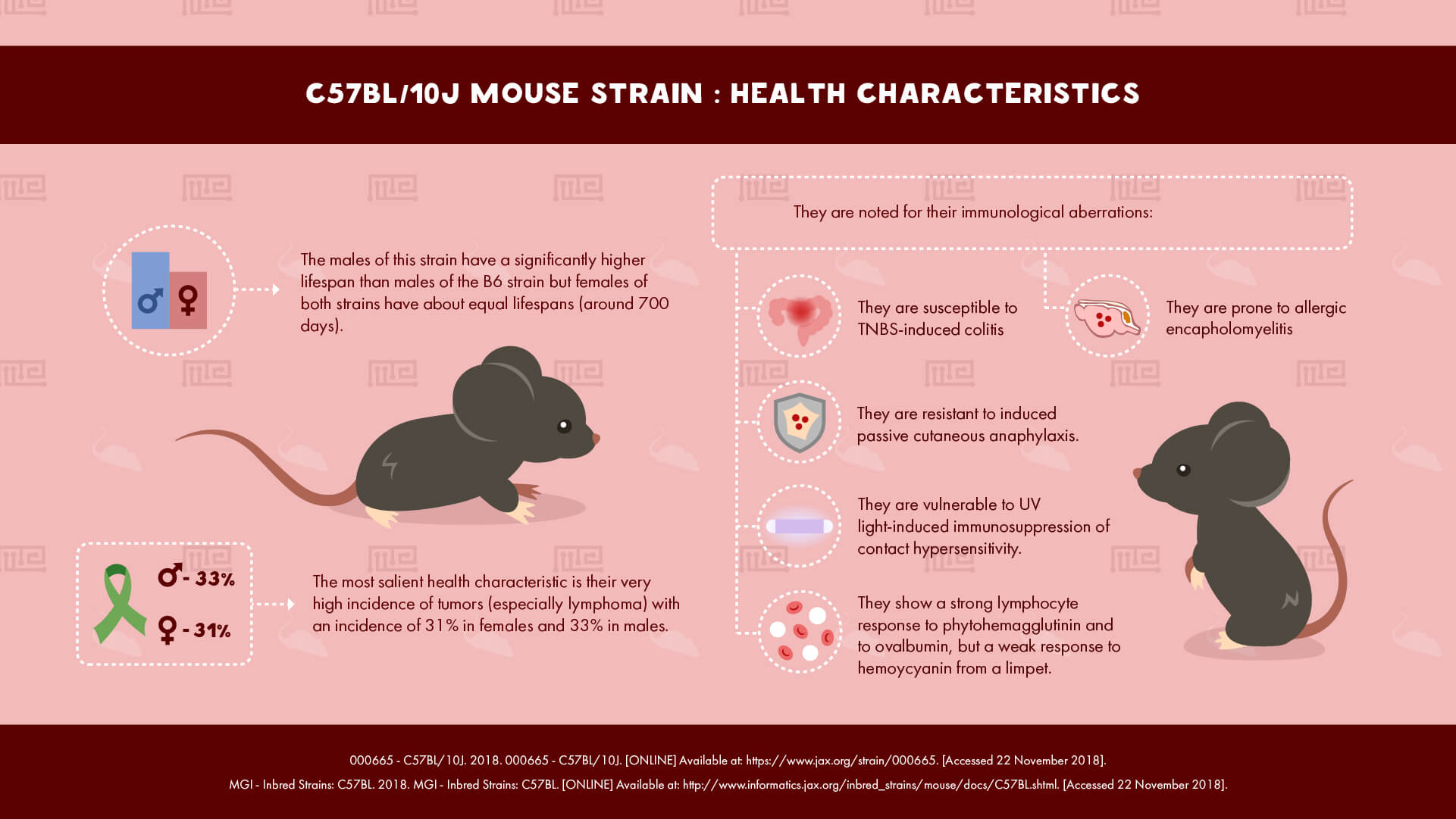Overview
C57BL/10J, also known as B10, is an inbred strain of mouse that is very closely related to the popular C57BL/6J strain. The two differ at several key genetic loci.[1]
History
The C57BL strains were derived from a mating carried out by Little in 1921 between mice designated “52” and “57”. This round of breeding was the origin point for a number of different strains, including C57BL, C57L, C57BR, and C58.[2]
C57BL/6 and C57BL/10 became distinct strains at some point during the 1930s. The current C57BL/10J lineage was finally established as an independent strain at the Jackson Laboratory in 1948.[1]
Physical Characteristics of C57BL/10J Mouse Strain
C57BL/10J is very similar in appearance to C57BL/6J, with very dark brown/black fur.[1] Notable physical features of this strain include small kidneys for their body weight and highly bristled foot pads.[2] They also have thicker tails and a higher overall mass than B6 mice.[3]
Behavioral Characteristics & Handling
In 2007, a research team based primarily at the University of Oxford, UK, undertook an extensive study[3] comparing the behavior of C57BL/10J with C57BL/6J. They found some noticeable differences in general day-to-day behavior, including less frequent digging and burrowing by B10 mice compared to B6. Nest construction and grooming were not significantly different.[3]
In terms of motor capability, B10 mice perform worse on the rotarod, falling earlier than B6, and also showing lower ability in the horizontal bar. Open field locomotion, however, was equivalent, despite B10 mice showing more frequent stereotyped jumping in their home cage.[3]
In terms of cognitive attributes, B10 mice are seen to perform quite well in the contextual fear conditioning test,[4] as well as in the Morris water maze[5] and T maze tests of spatial memory (although B6 performed better in the T maze test than B10).[3] Both of these strains perform equally well in the Lashley maze and appetitive Y maze.[3] Anxiety displayed by the two strains in the elevated plus maze was also about the same.[6]
No information on the handling of this strain could be found. While researchers generally report that the related B6 strain is quite docile, although more prone to biting than average, it is not known whether these observations translate to B10 mice. Researchers requiring a highly docile strain may want to avoid B10 mice as a precautionary measure.
Health Characteristics of C57BL/10J Mouse Strain
Lifespan for male B10 mice is significantly higher than males of the B6 strain, with the lifespans of females in both strains about equal (around 700 days).[2] The most salient health characteristic of C57BL/10J is their very high incidence of tumors (especially lymphoma) with an incidence of 31% in females and 33% in males.[1]
This strain is also noted for its immunological aberrations: they show a strong lymphocyte response to phytohemagglutinin and to ovalbumin, but a weak response to hemoycyanin from a limpet. They are resistant to induced passive cutaneous anaphylaxis but susceptible to TNBS-induced colitis, allergic encapholomyelitis and UV light-induced immunosuppression of contact hypersensitivity.[1]
Major Experimental Uses
C57BL/10J mice are significantly less popular than C57BL/6J but still find certain niche experimental uses. Most importantly, their immune system abnormalities make them a good model for immunological research. They can also be applied to the study of lymphoma and congenics.[1]
References
- 000665 – C57BL/10J. 2018. 000665 – C57BL/10J. [ONLINE] Available at: https://www.jax.org/strain/000665. [Accessed 22 November 2018].
- MGI – Inbred Strains: C57BL. 2018. MGI – Inbred Strains: C57BL. [ONLINE] Available at: http://www.informatics.jax.org/inbred_strains/mouse/docs/C57BL.shtml. [Accessed 22 November 2018].
- R.M.J. Deacon, C.L. Thomas, J.N.P. Rawlins, B.J. Morley. 2007. A comparison of the behavior of C57BL/6 and C57BL/10 mice. Behavioral Brain Research. 179. 239-247.
- Schimanski LA, Nguyen PV. Mouse models of impaired fear memory exhibit deficits in amygdalar LTP. Hippocampus. 2005;15:502–17.
- Symons JP, Davis RE, Marriott JG. Water-maze learning and effects of cholinergic drugs in mouse strains with high and low hippocampal pyra- midal cell counts. Life Sci. 1988;42:375–83.
- Trullas R, Skolnick P. Differences in fear motivated behaviors among inbred mouse strains. Psychopharmacology. 1993;111:323–31.


